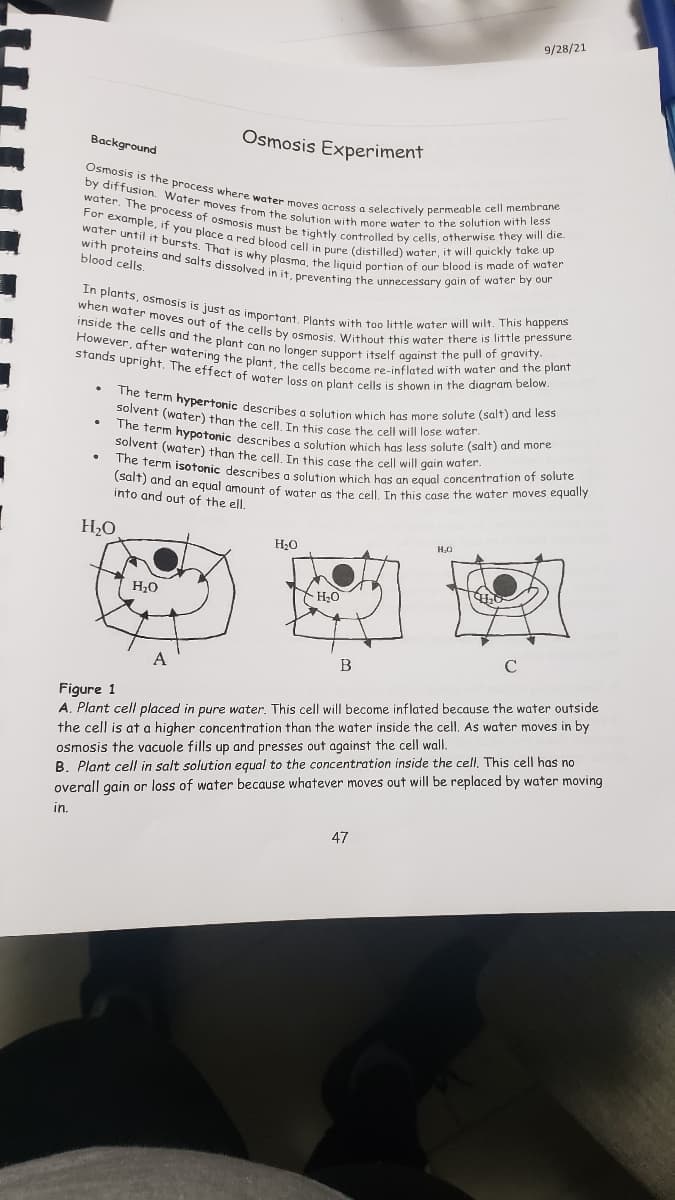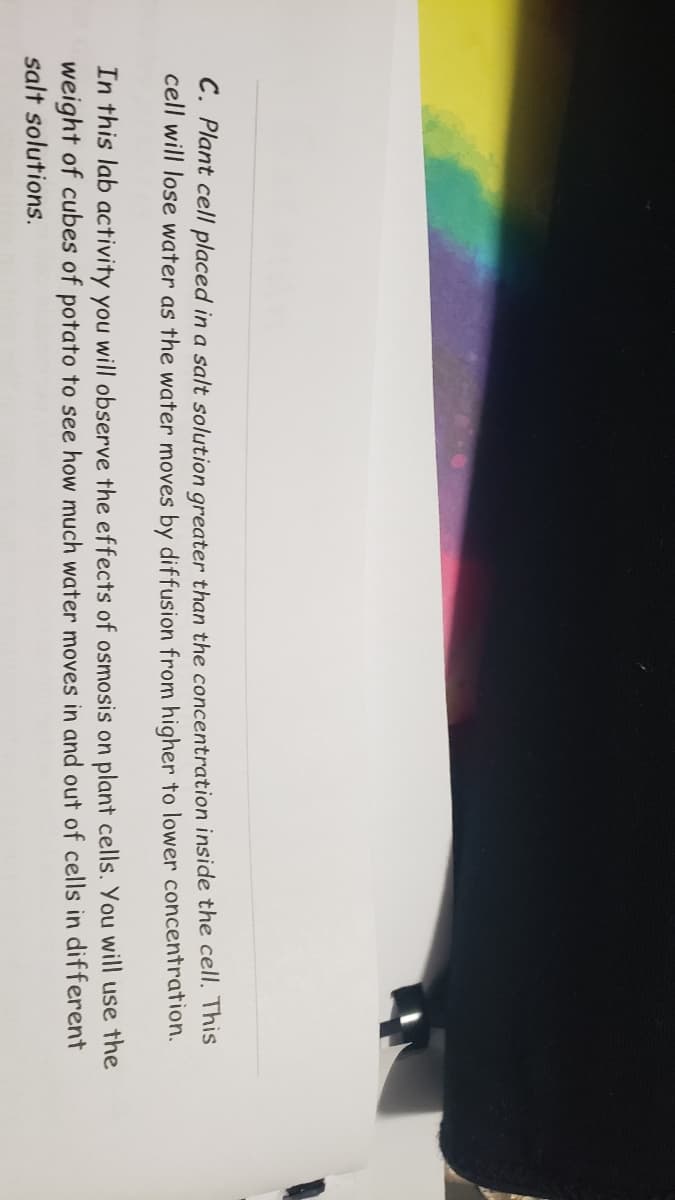Chemistry: An Atoms First Approach
2nd Edition
ISBN:9781305079243
Author:Steven S. Zumdahl, Susan A. Zumdahl
Publisher:Steven S. Zumdahl, Susan A. Zumdahl
Chapter10: Properties Of Solutions
Section: Chapter Questions
Problem 120CP: Plants that thrive in salt water must have internal solutions (inside the plant cells) that are...
Related questions
Question
Which will be an appropriate hypothesis for the experiment?

Transcribed Image Text:(salt) and an egual amount of water as the cell. In this case the water moves equally
Osmosis is the process where water moves across a selectively permeable cell membrane
The term isotonic describes a solution which has an equal concentration of solute
The term hypotonic describes a solution which has less solute (salt) and more
water, The process of osmosis must be tightly controlled by çells, otherwise they will die.
with proteins and salts dissolved in it, preventing the unnecessary gain of water by our
by diffusion. Water moves from the solution with more water to the solution with less
For example, if you place a red blood cell in pure (distilled) water, it will quickly take up
inside the cells and the plant can no longer support itself against the pull of gravity.
The term hypertonic describes a solution which has more solute (salt) and less
solvent (water) than the cell. In this case the cell will lose water.
In plants, osmosis is just as important, Plants with too little water will wilt. This happens
water until it bursts. That is why plaşma, the liquid portion of our blood is made of water
when water moves out of the cells by osmosis, Without this water there is little pressure
However, atter watering the plant, the cells become re-inflated with water and the plant
stands upright. The effect of water loss on plant cells is shown in the diagram below.
9/28/21
Osmosis Experiment
Background
blood cells.
solvent (water) than the cell In this case the cell will gain water
into and out of the ell.
H2O
H.O
H20
C
A
B
Figure 1
A. Plant cell placed in pure water. This cell will become inflated because the water outside
the cell is at a higher concentration than the water inside the cell. As water moves in by
osmosis the vacuole fills up and presses out against the cell wall.
B. Plant cell in salt solution equal to the concentration inside the cell, This cell has no
overall gain or loss of water because whatever moves out will be replaced by water moving
in.
47

Transcribed Image Text:C. Plant cell placed in a salt solution greater than the concentration inside the cell. This
cell will lose water as the water moves by diffusion from higher to lower concentration.
In this lab activity you will observe the effects of osmosis on plant cells. You will use the
weight of cubes of potato to see how much water moves in and out of cells in different
salt solutions.
Expert Solution
This question has been solved!
Explore an expertly crafted, step-by-step solution for a thorough understanding of key concepts.
Step by step
Solved in 2 steps

Knowledge Booster
Learn more about
Need a deep-dive on the concept behind this application? Look no further. Learn more about this topic, chemistry and related others by exploring similar questions and additional content below.Recommended textbooks for you

Chemistry: An Atoms First Approach
Chemistry
ISBN:
9781305079243
Author:
Steven S. Zumdahl, Susan A. Zumdahl
Publisher:
Cengage Learning


Chemistry
Chemistry
ISBN:
9781305957404
Author:
Steven S. Zumdahl, Susan A. Zumdahl, Donald J. DeCoste
Publisher:
Cengage Learning

Chemistry: An Atoms First Approach
Chemistry
ISBN:
9781305079243
Author:
Steven S. Zumdahl, Susan A. Zumdahl
Publisher:
Cengage Learning


Chemistry
Chemistry
ISBN:
9781305957404
Author:
Steven S. Zumdahl, Susan A. Zumdahl, Donald J. DeCoste
Publisher:
Cengage Learning

Chemistry & Chemical Reactivity
Chemistry
ISBN:
9781133949640
Author:
John C. Kotz, Paul M. Treichel, John Townsend, David Treichel
Publisher:
Cengage Learning

Chemistry: Principles and Reactions
Chemistry
ISBN:
9781305079373
Author:
William L. Masterton, Cecile N. Hurley
Publisher:
Cengage Learning

Chemistry: The Molecular Science
Chemistry
ISBN:
9781285199047
Author:
John W. Moore, Conrad L. Stanitski
Publisher:
Cengage Learning